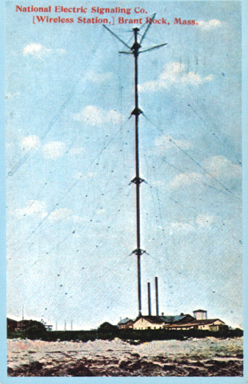 Blackmans
Point (Brant Rock) circa.1905
Blackmans
Point (Brant Rock) circa.1905
Fessenden arrives, sets up National Electric Signaling Co. and proceeds to make Communications History with many improvements to the State of the Art as known then. Picture is a 420 foot Radio tower as used by Fessenden. The ravages of time and the ruthless hand of ignorance, have laid waste to many monuments of antiquity but the remains of the original tower base stands today at Brant Rock as a memorial to such work, some of which surpassed Marconi, RCA, and other giants of the fledgling industry..
Reginald Aubrey Fessenden (1866-1932)
Canadian born - attended Bishop's College, Quebec - Became chief chemist for Thomas Edison and developed interest in the new media 'radio' - Professor of electrical engineering at Purdue and Univ. of Pittsburgh - Worked for U.S. Weather Bureau and set up telegraph stations - Sent first VOICE via radio for a distance of 50 feet (1900) - Formed National Electric Signalling Co., moved to Brant Rock - Set up 420 foot tower and similar station in Scotland for the first two way trans-Atlantic telegraph - Many radio inventions - Much success at Brant Rock - First general public VOICE Broadcasts (1905 -1906) - Helps build the local economy - Moves to New London and has a most successful career in Underwater Sound -
What he said of himself:
My parents despaired of me. They saw my future as a church minister or a teacher, but when I closed my eyes and dreamed, I saw an invention that could send voices around the world without using wires or cables. "There's no future in that," my mother told me, and she was both right and wrong.
In my lifetime, I developed over a hundred patentable inventions including the electric gyroscope, the heterodyne, and a depth finder. I built the first power generating station at Niagara Falls and I invented radio, sending the first wireless voice message in the world on Dec. 23, 1900.
But despite all my hard work, I lived most of my life near poverty. I fought years of court battles before seeing even a penny from my greatest inventions. And worst of all, I was ridiculed by journalists, businessmen, and even other scientists, for believing that voice could ever be transmitted without using wires. But by the time of my death, not only was I wealthy from my patents, all of those people who had laughed at my ideas were twisting the dials on their newly bought radios to hear the latest weather and news.
* Like Michael Dell and Bill Gates, he never finished College.. Ed.
Brant Rock Highlights:
After Brant Rock he moved to New London, Ct., creating many applications concerning underwater sound technology (communications and ranging). for the Navy..
* He won the Scientific American's Gold Medal in 1929 for the fathometer, which could determine the depth of water under a ship's hull. Fessenden eventually held 500 patents.. Some other milestones include the invention of turbo-electric drive for battleships, insulating electrical tape and many other underwater sound devices..
Thanks and 73s from Dave Riley - AA1A - Marshfield, Mass...
3-98